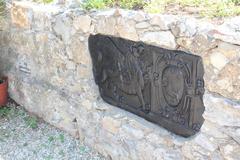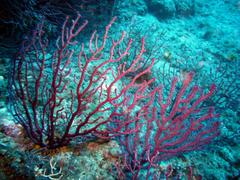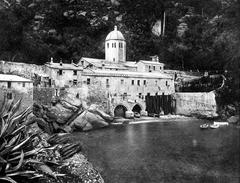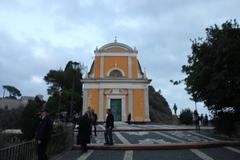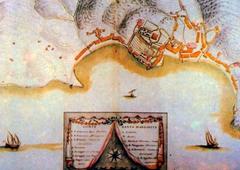Castello di Punta Pagana: Visiting Hours, Tickets, and Complete Guide to Rapallo’s Historic Fortress
Date: 04/07/2025
Introduction
Perched on the scenic Ligurian Riviera near Rapallo, Castello di Punta Pagana is a captivating testament to Genoa’s 17th-century military architecture. Overlooking the Gulf of Tigullio, this fortress exemplifies the strategic ingenuity of the Republic of Genoa, built to defend the coastline against incursions and piracy. Today, the castle’s historic stone walls, moat, and drawbridge are preserved within the private estate of the Sovereign Military Order of Malta, making it one of Liguria’s most intriguing—yet exclusive—historical sites.
This comprehensive guide explores the origins, architectural features, cultural significance, and practical visitor information for Castello di Punta Pagana. Whether you’re a history enthusiast, architecture aficionado, or simply planning a trip to Rapallo, here you’ll find everything you need to know, including access protocols, nearby attractions, travel tips, and answers to frequently asked questions.
Table of Contents
- Origins and Construction
- Strategic and Historical Role
- Architectural Features and Preservation
- Visitation: Hours, Tickets, and Access
- Travel Tips and Nearby Attractions
- Visitor Experience and Accessibility
- FAQs
- Conclusion
- Sources
Origins and Construction
Castello di Punta Pagana was constructed between 1625 and 1631 during a period of heightened tension between the Republic of Genoa and the Duchy of Savoy. Genoa, intent on safeguarding its coastline from potential invasions and pirate raids, initiated a comprehensive network of coastal defenses. The castle was strategically positioned on the Punta Pagana promontory for its commanding views of the Gulf of Tigullio, enabling early detection of enemy ships.
Funding for the fortress came from the Republic and contributions by local municipalities, including Rapallo, Recco, Chiavari, Moneglia, and Sestri Levante (Morabito Immobiliare). Built with durable local stone, the castle featured robust defensive elements—thick walls, a moat, and a drawbridge—designed to withstand artillery and infantry attacks (Italyscapes).
Strategic and Historical Role
Castello di Punta Pagana formed part of a sophisticated defensive chain with neighboring forts like the Castello di Rapallo and Santa Margherita Ligure fortress. Its placement on a promontory surrounded by the sea maximized its surveillance and defensive capabilities (SpottingHistory). Although the castle never saw active combat, it was continuously garrisoned throughout the 17th century, serving as an effective deterrent.
By the early 18th century, as external threats waned, the fortress was gradually abandoned as a military outpost. In 1959, Admiral Franco Spinola bequeathed the estate, including the castle and Villa Pagana, to the Sovereign Military Order of Malta, ensuring its preservation.
Architectural Features and Preservation
Key Features:
- Moat and Drawbridge: Provided defense against landward attacks and remain visually striking.
- Thick Stone Walls: Designed to absorb cannon fire and withstand sieges.
- Narrow Windows and Bastions: Allowed for defensive gunfire and observation.
- Integration with Landscape: The castle is enveloped by Mediterranean vegetation, offering panoramic sea views and blending history with nature.
The private status of the estate has prevented urban encroachment, allowing the site to retain its historical atmosphere and architectural integrity (Morabito Immobiliare).
Visitation: Hours, Tickets, and Access
Access Overview:
Castello di Punta Pagana is not generally open to the public, as it resides within the private grounds of the Sovereign Military Order of Malta. However, on rare occasions—such as national heritage days or by special appointment—guided tours may be organized. These are typically announced through the Rapallo tourist office or the Order of Malta’s official channels.
- Regular Hours: No set public opening hours.
- Tickets: When tours are available, a nominal fee (usually €5–€10) is charged; advance booking is essential due to limited capacity.
- How to Book: Contact the Rapallo tourist office or the Order of Malta. Stay updated via Spellbinding Italy.
Viewing the Castle:
Even when the castle is closed, it can be admired from the sea. Boat tours traveling between Rapallo, Santa Margherita Ligure, and Portofino offer excellent vantage points.
Travel Tips and Nearby Attractions
Getting There:
- By Car: Use the A12 motorway (Rapallo exit), following signs toward Santa Margherita Ligure.
- By Train: Rapallo station is a 30-minute walk or short taxi ride from the castle.
- By Bus: Local buses connect Rapallo, Santa Margherita Ligure, and Portofino.
- On Foot: Enjoy a coastal walk from Rapallo or Santa Margherita Ligure for scenic views (Spellbinding Italy).
Nearby Attractions:
- Castello di Rapallo: 16th-century seaside fortress open to visitors.
- Santa Margherita Ligure Fortress: Panoramic historic site.
- Rapallo Old Town: Streets lined with shops, cafes, and heritage landmarks.
- Coastal Trails: Hiking routes in Parco Naturale Regionale di Portofino.
Visitor Experience and Accessibility
Guided Tours:
When available, tours typically last 45–60 minutes, covering the castle’s history, architecture, and gardens. Tours are generally in Italian, with English available on request. Group sizes are limited (10–20 people) to protect the site.
Accessibility:
The castle’s terrain includes steps and gravel paths, making it challenging for visitors with limited mobility. Contact the venue in advance to discuss possible accommodations.
Facilities:
Onsite facilities are minimal—no cafés or shops—so bring water and supplies. Restrooms may be available only during events.
Photography:
Permitted outdoors; interior photography subject to guide approval.
Etiquette:
Wear comfortable shoes and respectful attire. Stay on marked paths and help preserve the site.
FAQs
Q: Can I visit Castello di Punta Pagana whenever I want?
A: No. Access is limited to special events or pre-arranged guided tours.
Q: How do I book a visit?
A: Through the Rapallo tourist office or Order of Malta during announced openings.
Q: Is the site accessible for wheelchairs?
A: Accessibility is limited due to uneven terrain; contact organizers for specific arrangements.
Q: Are pets allowed?
A: Generally not permitted, to protect the environment.
Q: When is the best time to visit?
A: Late spring and early autumn offer pleasant weather and fewer tourists.
Conclusion
Castello di Punta Pagana stands as a compelling symbol of Liguria’s coastal heritage and Genoese military history. Its restricted access has aided preservation, making public openings rare but highly rewarding. Planning ahead and coordinating with local tourism offices or the Sovereign Military Order of Malta is essential for those wishing to experience this historic fortress firsthand.
Enhance your Ligurian adventure by exploring nearby attractions and, for real-time updates and curated itineraries, download the Audiala app. Respect the site’s privacy and preservation needs to ensure its legacy endures for future generations.
Sources
- This article draws on research and official visitor information from Morabito Immobiliare, Italyscapes, SpottingHistory, FAI official site, and Spellbinding Italy.
